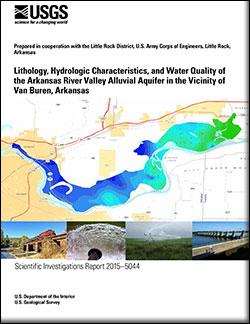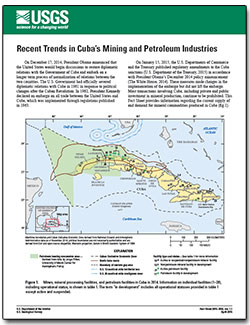Filters: Types: OGC WMS Service (X) > Extensions: Citation (X)
323 results (28ms)|
Filters
Date Range
Extensions Types
Contacts
Categories Tag Types
|
Final Report - Executive Summary: This final project report is prepared to summarize the research project titled “Assessing evapotranspiration rate changes for proposed restoration of the forested uplands of the Desert Landscape Conservation Cooperatives (LCC)” for the Desert LCC of the Bureau of Reclamation as a requirement for closing out the project. This report includes the scope of work, summary of research project, results, and conclusions.Among all of the components of the terrestrial water cycle, evapotranspiration (ET) consumes the largest amount of water. Accurate estimation of ET is very important to understand the influence of ET to the hydrologic response of recharge and runoff processes in the water...
Categories: Data,
Publication;
Types: Citation,
Map Service,
OGC WFS Layer,
OGC WMS Layer,
OGC WMS Service;
Tags: 2012,
ATMOSPHERE,
ATMOSPHERE,
ATMOSPHERIC WATER VAPOR,
ATMOSPHERIC WATER VAPOR,
The data set includes delineation of sampling strata for the six study reaches of the UMRR Program’s LTRM element. Separate strata coverages exist for each of the three monitoring components (fish, vegetation, and water quality) to meet the differing sampling needs among components. Generally, the sampling strata consist of main channel, side channel, backwater, and impounded areas. The fish component further delineates a “shoreline” portion of the strata to be used for sampling gears deployed only along the shoreline. The data are raster in origin, with the center of each pixel representing the sampling location. Cell size is typically 50 meters, although several water quality strata are at 200 meter cell size.
Categories: Data,
Publication;
Types: Citation,
Downloadable,
Map Service,
OGC WFS Layer,
OGC WMS Layer,
OGC WMS Service,
Shapefile;
Tags: Mississippi River,
Navgation Pool 13,
Upper Mississippi River,
aquatic areas,
sampling strata
Abstract Coastal marsh within Mediterranean climate zones is exposed to episodic watershed runoff and sediment loads that occur during storm events. Simulating future marsh accretion under sea level rise calls for attention to: (a) physical processes acting over the time scale of storm events and (b) biophysical processes acting over time scales longer than storm events. Using the upper Newport Bay in Southern California as a case study, we examine the influence of event-scale processes on simulated change in marsh topography by comparing: (a) a biophysical model that integrates with an annual time step and neglects event-scale processes (BP-Annual), (b) a physical model that resolves event-scale processes but...
Categories: Publication;
Types: Citation,
Map Service,
OGC WFS Layer,
OGC WMS Layer,
OGC WMS Service
Abstract Unpaved forest roads remain a pervasive disturbance on public lands and mitigating sediment from road networks remains a priority for management agencies. Restoring roaded landscapes is becoming increasingly important for many native coldwater fishes that disproportionately rely on public lands for persistence. However, effectively targeting restoration opportunities requires a comprehensive understanding of the effects of roads across different ecosystems. Here, we combine a review and a field study to evaluate the status of knowledge supporting the conceptual framework linking unpaved forest roads with streambed sediment. Through our review, we specifically focused on those studies linking measures of...
Much remains unknown about the genetic status and population connectivity of high-elevation and high-latitude freshwater invertebrates, which often persist near snow and ice masses that are disappearing due to climate change. Here we report on the conservation genetics of the meltwater stonefly Lednia tumana (Ricker) of Montana, USA, a cold-water obligate species. We sequenced 1530 bp of mtDNA from 116 L. tumana individuals representing “historic” (>10 yr old) and 2010 populations. The dominant haplotype was common in both time periods, while the second-most-common haplotype was found only in historic samples, having been lost in the interim. The 2010 populations also showed reduced gene and nucleotide diversity...
Description: The upper Gila River in New Mexico is one of the few unobstructed rivers in the Colorado River Basin with largely intact native fish populations, including four federally listed and one state listed species.Freshwater systems throughout the West continue to be threatened by human encroachment and water development. Methodologies or decision support tools to evaluate resource management practices that foster an understanding of how fish species adapt to the effects of climate change are critical to future resource management planning.
Categories: Data,
Publication;
Types: Citation,
Map Service,
OGC WFS Layer,
OGC WMS Layer,
OGC WMS Service;
Tags: 2011,
AZ-01,
AZ-02,
Academics & scientific researchers,
Applications and Tools,
Watersheds draining the Arctic Coastal Plain (ACP) of Alaska are dominated by permafrostand snowmelt runoff that create abundant surface storage in the form of lakes, wetlands, and beaded streams. These surface water elements compose complex drainage networks that affect aquatic ecosystem connectivity and hydrologic behavior. The 4676 km2 Fishand Creek drainage basin is composed of three watersheds that represent a gradient of theACP landscape with varying extents of eolian, lacustrine, and fluvial landforms. In each watershed, we analyzed 2.5-m-resolution aerial photography, a 5-m digital elevationmodel, and river gauging and climate records to better understand ACP watershed structureand processes. We show that...
Stream fragmentation alters the structure of aquatic communities on a global scale, generally through loss of native species. Among riverscapes in the Great Plains of North America, stream fragmentation and hydrologic alteration (flow regulation and dewatering) are implicated in the decline of native fish diversity. This study documents the spatio–temporal distribution of fish reproductive guilds in the fragmented Arkansas and Ninnescah rivers of south-central Kansas using retrospective analyses involving 63 years of fish community data. Pelagic-spawning fishes declined throughout the study area during 1950–2013, including Arkansas River shiner (Notropis girardi) last reported in 1983, plains minnow (Hybognathus...
Categories: Data,
Publication;
Types: Citation,
Map Service,
OGC WFS Layer,
OGC WMS Layer,
OGC WMS Service;
Tags: CATFISHES/MINNOWS,
Colorado,
Colorado,
FISH,
Federal resource managers,
Habitat fragmentation and flow regulation are significant factors related to the decline and extinction of freshwater biota. Pelagic-broadcast spawning cyprinids require moving water and some length of unfragmented stream to complete their life cycle. However, it is unknown how discharge and habitat features interact at multiple spatial scales to alter the transport of semi-buoyant fish eggs. Our objective was to assess the relationship between downstream drift of semi-buoyant egg surrogates (gellan beads) and discharge and habitat complexity. We quantified transport time of a known quantity of beads using 2–3 sampling devices at each of seven locations on the North Canadian and Canadian rivers. Transport time was...
We used the United States National Grid to develop a sampling grid for monitoring programs in the Great Plains Landscape Conservation Cooperative, delineated by Bird Conservation Regions 18 and 19. Landscape Conservation Cooperatives are science based partnerships with the goal to inform and guide conservation at regional landscape levels. Developing a standardized sampling grid for a LCC is a new endeavor and is designed to reduce program costs, avoid repetition in sampling, and increase efficiency in monitoring programs. This is possible because the grid’s nationwide coverage, uniform starting point, and scalability allow researchers to expand their monitoring programs from a small, local level to a regional or...
Categories: Data,
Publication;
Types: Citation,
Map Service,
OGC WFS Layer,
OGC WMS Layer,
OGC WMS Service;
Tags: BIRDS,
Colorado,
Colorado,
Federal resource managers,
Final Report,
Publications that have used data collected during the Spoon-billed Sandpiper surveys.
Categories: Data,
Publication;
Types: Citation,
Map Service,
OGC WFS Layer,
OGC WMS Layer,
OGC WMS Service;
Tags: ANIMALS/VERTEBRATES,
Arctic,
BIOLOGICAL CLASSIFICATION,
BIRDS,
EARTH SCIENCE,

Categories: Publication;
Types: Citation,
Map Service,
OGC WFS Layer,
OGC WMS Layer,
OGC WMS Service;
Tags: Scientific Investigations Report

Categories: Publication;
Types: Citation,
Map Service,
OGC WFS Layer,
OGC WMS Layer,
OGC WMS Service;
Tags: Fact Sheet
Estimated potential for sage-grouse movement among sage-grouse leks (Circuitscape; McRae 2006). Rescaled HSI values were used as a measure of landscape resistance
Categories: Data,
Publication;
Types: Citation,
Map Service,
OGC WFS Layer,
OGC WMS Layer,
OGC WMS Service;
Tags: Connectivity,
Data,
EARTH SCIENCE > LAND SURFACE > LANDSCAPE,
Environment and Conservation,
Federal resource managers,
These layers show land ownership and status of all Canadian and U.S. lands that fall within the boundaries of the Great Northern Landscae Conservation Cooperative. Layers were compiled from various sources, each with it’s own metadata reference file.
Categories: Data,
Publication;
Types: ArcGIS REST Map Service,
ArcGIS Service Definition,
Citation,
Downloadable,
Map Service,
OGC WFS Layer,
OGC WMS Layer,
OGC WMS Service;
Tags: Boundaries,
Data,
Data.gov Great Northern Landscape Conservation Cooperative,
EARTH SCIENCE > LAND SURFACE > LANDSCAPE,
Federal resource managers,
There is a great deal of interest in whether and how Alaska’s precipitation is changing but little agreement in the existing peer-reviewed literature. To provide insight on this question, we have selected three commonly used 0.5° resolution gridded precipitation products that have long-term monthly data coverage (Climatic Research Unit TS3.10.1, Global Precipitation Climatology Centre Full Data Reanalysis version 5, and University of Delaware version 2.01) and evaluated their homogeneity and trends with multiple methods over two periods, 1950–2008 and 1980–2008. All three data sets displayed common broadscale features of Alaska’s precipitation climatology, but there were substantial differences between them in terms...
The Healthy Beaches for People and Fish project was completed by Friends of the San Juans in partnership with Coastal Geologic Services, Salish Sea Biological and the Washington Department of Fish and Wildlife in 2014. Project approach and work was guided by a technical advisory group, which included representatives from The University of Washington, United States Geological Survey, Puget Sound Partnership, Skagit River Systems Cooperative, Samish Indian Nation, San Juan County Public Works, San Juan County Salmon Recovery Lead Entity, The Tulalip Tribes, Padilla Bay National Estuarine Research Reserve and the Washington State Departments of Ecology, Natural Resources and Fish and Wildlife. The project contained...
Categories: Data,
Publication;
Types: Citation,
Map Service,
OGC WFS Layer,
OGC WMS Layer,
OGC WMS Service;
Tags: LCC Network Science Catalog,
Publication,
Report,
San Juan County, WA,
San Juan Islands,
We used publically available data on duck breeding distribution and recently compiled geospatialdata on upland habitat and environmental conditions to develop a spatially explicitmodel of breeding duck populations across the entire Prairie Pothole Region (PPR). Ourspatial population models were able to identify key areas for duck conservation across thePPR and predict between 62.1 – 79.1% (68.4% avg.) of the variation in duck counts by yearfrom 2002 – 2010. The median difference in observed vs. predicted duck counts at a transectsegment level was 4.6 ducks. Our models are the first seamless spatially explicit modelsof waterfowl abundance across the entire PPR and represent an initial step toward jointconservation...
Categories: Data,
Publication;
Types: Citation,
Map Service,
OGC WFS Layer,
OGC WMS Layer,
OGC WMS Service;
Tags: Conservation NGOs,
Conservation Planning,
EARTH SCIENCE > LAND SURFACE > LANDSCAPE,
Federal resource managers,
LCC,
Climate change vulnerability assessments are commonly used to identify species or populations at risk from global climate change, but few translate impact assessments to climate change adaptation actions. Furthermore, most climate change adaptation efforts emphasize where to implement management actions, whereas timing remains largely overlooked. The rate of modern climate change introduces urgency in evaluating whether delaying conservation actions compromises their efficacy for reaching important conservation targets. We evaluated the importance of multiple climate change adaptation strategies including timing of actions on preventing extinctions for a threatened climate-sensitive species, the Eastern Massasauga...
Understanding how climate change and variability will impact grassland ecosystems is crucial for successful grassland management in the 21st century. In 2020, the U.S. Geological Survey North Central Climate Adaptation Science Center (USGS NC CASC) began a project to establish a baseline of information to best serve grassland managers (that is, those who develop grassland management plans or implement those plans on the ground) at Federal, State, and Tribal agen-cies and nongovernmental organizations to help meet regional grassland management goals. This project “A Synthesis of Climate Impacts, Stakeholder Needs, and Adaptation in Northern Great Plains Grassland Ecosystems” (hereafter, the Grasslands Synthesis Project),...
Categories: Publication;
Types: Citation,
Map Service,
OGC WFS Layer,
OGC WMS Layer,
OGC WMS Service
|

|